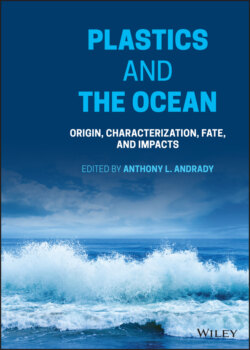Читать книгу Plastics and the Ocean - Группа авторов - Страница 41
2.2.2 Flame Retardants
ОглавлениеPlastics, especially those with a high carbon content, are inherently flammable. For many resins, the most cost‐effective method for increasing fire safety is to blend a FR additive into polymer formulations (Troitzsch and Antonatus 2021; Zweifel et al. 2001). FRs can be classified into halogen‐based, phosphorus‐based, and metal hydrate compounds. Halogen‐based FRs can vary widely in chemical structure, but the most common types are brominated organic compounds (BFRs), including polybrominated diphenyl ethers (PBDEs), hexabromocyclododecane (HBCD), tetrabromobisphenol A (TBBPA), and polybrominated biphenyls (PBBs; Figure 2.1). HBCDs are the most widely used BFRs, with 31 000 metric tons produced in 2011 (UNEP 2015).
These FRs work in the vapor or gas state and interfere with the radical mechanism of the combustion process. Plastics, such as polyethylene (PE), high‐impact polystyrene, ethylene‐vinyl acetate copolymer, and acrylonitrile‐butadiene‐styrene (ABS) copolymer, use PBDEs as FRs (Andrady and Rajapakse 2019; Delva et al. 2018; Rahman et al. 2001). Recently, many PBDEs, such as penta‐BDE, octa‐BDE, and deca‐BDE, have been phased out due to their significant persistence and toxicity. New BFRs, such as 1,2‐bis(2,4,6‐tribromophenoxy) ethane, have been developed as substitutes (Sun et al. 2019). Phosphate‐based FRs, such as tri(2‐chloroethyl) phosphate (TCEP) or tris(2‐ethylhexyl)phosphate are char formers that produce phosphoric acids that react with the substrate to generate a char that protects the polymer itself from combustion (Ambrogi et al. 2017; Samani and van der Meer 2020). Metal hydrate FRs are typically aluminum trihydroxide and magnesium hydroxide that hydrates decompose under high heat to release water, preventing propagation (Innes and Innes 2002).
Table 2.2 Eight of the most commonly used phthalate plasticizers in PVC.
Source of data: Zero Breast Cancer. (2014). “Phthalates: The Everywhere Chemical.” Retrieved October 8 2020, from https://www.niehs.nih.gov/research/supported/assets/docs/j_q/phthalates_the_everywhere_chemical_handout_508.pdf.
| Name | Abbreviation | Common metabolites | Banned in toys and childcare articles in EU | Banned in U.S. toys or childcare articles |
|---|---|---|---|---|
| Butyl benzyl phthalate | BBP | Mono benzyl phthalate (MBzP) | X | X |
| Di‐n‐butyl phthalate | DnBP | Mono‐n‐butyl phthalate (MnBP); mono‐isobutyl phthalate (MiBP) | X | X |
| Di‐(2‐ethylhexyl) phthalate | DEHP | Mono‐(2‐ethylhexyl) phthalate (MEHP); mono‐(2‐ethyl‐5‐hydroxyhexyl) phthalate (MEHHP); mono‐(2‐ethyl‐5‐oxohexyl) phthalate (MEOHP); mono‐(2‐ethyl‐5‐carboxypentyl) phthalate (MECPP) | X | X |
| Diethyl phthalate | DEP | Monoethyl phthalate (MEP) | ||
| Di‐isodecyl phthalate | DiDP | Mono‐(carboxynonyl) phthalate (MCNP) | X | |
| Di‐isononyl phthalate | DiNP | Mono‐isononyl phthalate (MiNP) | X | X |
| Di‐n‐hexyl phthalate | DnHP | X | ||
| Di‐n‐octyl phthalate | DnOP | Mono‐(3‐carboxypropyl) phthalate (MCPP); mono‐n‐octyl phthalate (MOP) | X |
Note: Several phthalates have been banned by the European Union (EU) or the United States for use in toys or childcare articles at concentrations >0.1% (ZBC 2018).
Figure 2.1 Chemical structures of (a) PBDE, (b) HBCD, (c) TBBPA, and (d) PBB.
FRs have a high propensity to migrate out of the plastic into surrounding environments. Some FRs are used as mixtures of congeners, such as commercial PBDEs, with certain congeners more toxic than others. Although some commercial PBDEs (penta‐BDE, octa‐BDE, and deca‐BDE) have been phased out (Sharkey et al. 2020), they will remain in the environment for many years because of their persistence.
